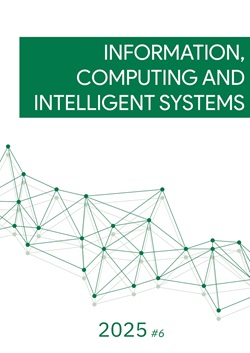Mathematical Model of Clustering of Informational Messages with Indicators of Activity for the Information Content by Tone and Areas of Society Activity
DOI:
https://doi.org/10.20535/2786-8729.6.2025.339127Keywords:
Big Data, clustering, Natural Language ProcessingAbstract
The mathematical model of clustering of information messages has been further developed, which is based on the frequency analysis of their tonality using Natural Language Processing methodologies with the support of large language models; OLAP visualization of clustering results and is distinguished by an established system of indicators of information content activity by areas of society activity with hierarchical compression of incoming Big Data arrays, which determines the database model for their storage. This provides an improvement to the analysis of information messages in global information networks by taking into account many factors in the areas of society activity.
The main idea and goal of the mathematical model for clustering information messages is to implement a sequence of preparation stages for detecting critical activity of the information content in global media. In practice, this is the establishment of a list and the determination of indicator values that measure content activity in primary messages, followed by their transformation into a time series – a systematized dataset. In the conditions of high density of the flow of occurrence, dynamics of development, and transformation of information content, a Big Data structure of information messages is taken into account. Therefore, the clustering model, apart from division by informational features, should provide the hierarchical compression of incoming Big Data arrays.
Research objective: development of a mathematical model of clustering information messages with indicators of information content activity by tone and spheres of activity of society. Research subject: methods of clustering information messages. Research object: process of clustering information messages.
References
O. Pysarchuk, A. Gizun, A. Dudnik, V. Griga, T. Domkiv, and S. Gnatyuk, “Bifurcation prediction method for the emergence and development dynamics of information conflicts in cybernetic space,” in Proc. 1st Int. Workshop on Cyber Hygiene & Conflict Management in Global Information Networks (CyberCon-2019), Kyiv, Ukraine, 2019, pp. 692–709. [Online]. Available: https://ceur-ws.org/Vol-2654/paper54.pdf. Accessed: Aug. 1, 2025.
S. Pitafi, T. Anwar, and Z. Sharif, “A taxonomy of machine learning clustering algorithms, challenges, and future realms,” Appl. Sci., vol. 13, no. 6, p. 3529, 2023. https://doi.org/10.3390/app13063529
O. Puchkov, D. Lande, and I. Subach, “Methods of creating, clustering and visualization of correlation networks determined by the dynamics of thematic information flows,” Inf. Technol. Secur., vol. 3, no. 1, pp. 6–16, 2025. https://doi.org/10.20535/2411-1031.2025.13.1.328753
D. Lande and L. Strashnoy, “Advanced Semantic Networking Based on the Large Language Models: Monograph”. Kyiv, Ukraine: Engineering, 2025, 258 p. ISBN: 978-617-8180-02-7.
S. Al-Yazidi, J. Berri, M. Al-Qurishi, and M. Al-Alrubaian, “Measuring reputation and influence in online social networks: a systematic literature review,” IEEE Access, vol. 8, pp. 105824–105851, 2020. https://doi.org/10.1109/ACCESS.2020.2999033
V. Ananthaswamy and B. Seethalakshmi, “Mathematical analysis of information dissemination model for social networking services,” Am. J. Model. Optim., vol. 3, no. 1, pp. 26–34, 2015. [Online]. Available: https://pubs.sciepub.com/ajmo/3/1/4/
J. Dong, B. Chen, L. Liu, C. Ai, and F. Zhang, “The analysis of influencing factors of information dissemination on cascade size distribution in social networks,” IEEE Access, vol. 6, pp. 54185–54194, 2018. [Online]. Available: https://ieeexplore.ieee.org/document/8472147
P. Cui, B. Yin, and B. Xu, “The application of social recommendation algorithm integrating attention model in movie recommendation,” Sci. Rep., vol. 13, no. 1, pp. 169–188, 2023. [Online]. Available: https://www.nature.com/articles/s41598-023-43511-1. Accessed: Aug. 1, 2025.
“Vybukhy u Kryvomu Rozi 4 kvitnia 2025 roku: shcho vidomo,” Fakty.ua, 5 kvit. 2025. [Online]. Available: https://fakty.com.ua/ua/proisshestvija/20250405-vybuhy-u-kryvomu-rozi-4-kvitnya-2025-roku-shho-vidomo/ [in Ukrainian]. Accessed: Aug. 1, 2025.
“Vybukhy u Kyievi u trokh raionakh stolytsi: stalysia pozhezhi cherez raketnu ataku RF,” Fakty.ua, 6 kvit. 2025. [Online]. Available: https://fakty.com.ua/ua/proisshestvija/20250406-vybuhy-u-kyyevi-u-troh-rajonah-stolyczi-stalysya-pozhezhi-cherez-raketnu-ataku-rf/ [in Ukrainian]. Accessed: Aug. 1, 2025.
Downloads
Published
How to Cite
Issue
Section
License
Copyright (c) 2025 Information, Computing and Intelligent systems

This work is licensed under a Creative Commons Attribution 4.0 International License.




